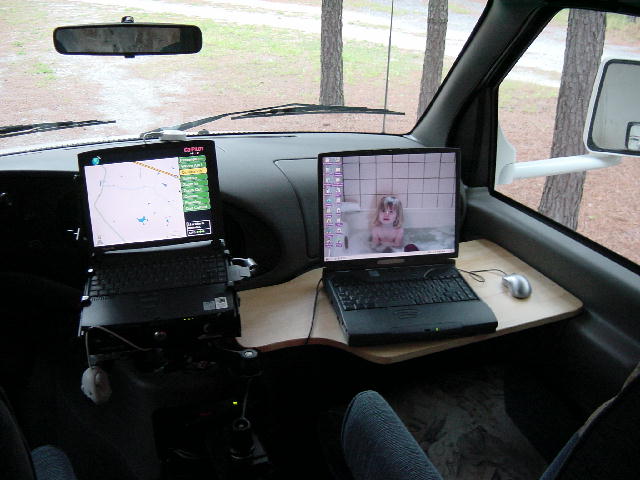| The Lustik Travel Home Page |
Computer / Internet Technology
Click here to go back to the Frontier Home Page.
This page is meant to explain what types of computer technology and Internet connections we used during our travels.
We use our Internet connections to update this website; keep in touch with family and friends; and they allow Christine to continue taking Masters classes on-line while we travel.

| Internet Connection Possibilities | |
| Connection Type: | Connection Description |
| Verizon Digital: | We are on the national "Single-Rate" plan with Verizon. Supposedly our phone should work anywhere we get a digital signal indication on the phone, with no roaming or long-distance charges. We pay for a monthly allowance of 400 minutes. We pay an extra $7/mo for internet browser capabilities. This includes micro-browser capabilities built directly into the phone, which we don't use. The connection cable plugs into the laptops serial port. |
|
Positives: |
The connection occurs very rapidly (6 seconds) since it is pure digital. The 19.2 kb throughput is very fast in an all digital environment because nothing is lost through the modulation/demodulation function of a modem. Actual web browsing performance is comparable to a typical 38 kb dial-up modem connection. The digital connection holds on longer to a weak signal. |
|
Negatives: |
Verizon's national digital network is not as all-encompassing as they would have you believe. Early on we had to demand that Verizon publish our telephone number to all the other providers involved in their reciprocal relationship. Even still we reach areas where digital service is denied. Also, getting through Verizon's technical support maze is very discouraging as they continue their effort to bring all their acquisitions under single control. We would not suggest you use Verizon. |
| Verizon Analog: | Since digital signals are still reserved for heavily populated areas, the majority of our travels cover a geography most often serviced only by an analog signal, or no signal at all. We purchased a Motorola Global Modem on a PCMCIA Card that is compatible with our phone. The analog service by definition is slow, about 4.8 kb through a modem. This limits its use to voice, or simple e-mail functions. Web browsing is out of the question at that speed. |
| Positives: | We have nothing positive to say about this. |
| Negatives: | The Motorola modem connection is very finicky. Verizon has worked hard to establish a reciprocal national network for digital coverage, but the focus on analog providers is missing. Many rural areas are served by small regional cellular providers that aren't in Verizon's family. We have gotten no productive use out of this connection, but plenty of frustration with each attempt. |
| Earthlink Local: | Earthlink is our ISP (Internet Service Provider), e-mail host, and web host. We chose them because they are the second largest in the country, and they try harder than AOL, the largest. They have a large database of points of presence that allow us to frequently connect via a local dial up, without charges. This is for when we are in a campground that has a modem hook-up in the office or at the campsite. Most of the campgrounds where we stay have at the least, a connection in the office. |
| Positives: | Reliable. Easy on-line search tool to find local dial-up numbers. |
| Negatives: | Un-published directory of local dial-up numbers. This requires us to connect via the 800# to use the Earthlink website query tool to find a local dial-up number, then disconnect and reconnect with the local number. |
| Earthlink 800: | Another reason for choosing Earthlink. We pay an extra $5/mo for five hours of connecting via an 800#. This permits us to dial-up from anywhere that we can hook-up without having to deal with toll calls. |
| Positives: | Reliable. |
| Negatives: | $6/hour of use after the five pre-paid hours have been used. |
|
Libraries: |
For heavy web-browsing it is hard to beat the convenience of library use. The library connections are usually much faster than dial-up, and we can each surf simultaneously. |
| Positives: | Almost every single library we have visited has at least a few computers connected to the internet. |
| Negatives: | Most libraries limit use to once a day (20-60 minutes), though we can stay on longer if no one is waiting. Most do not provide access to the floppy disk drive (no uploading or downloading to/from our laptops). |